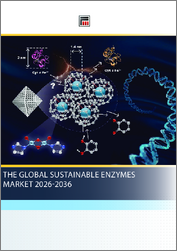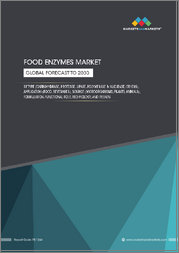
|
시장보고서
상품코드
1722961
세계의 효소 시장 규모, 점유율, 동향, 예측 : 유형, 원료, 반응 유형, 용도, 지역별(2025-2033년)Enzymes Market Size, Share, Trends and Forecast by Type, Source, Reaction Type, Application, and Region, 2025-2033 |
||||||
효소 세계 시장 규모는 2024년 139억 7,000만 달러에 달했습니다. 향후 IMARC Group은 이 시장이 2033년까지 219억 달러에 달하고, 2025-2033년 5.3%의 연평균 복합 성장률(CAGR)을 보일 것으로 예측했습니다. 현재 북미가 시장을 독점하고 있으며, 2024년 시장 점유율은 36.8% 이상에 달했습니다. 식품, 헬스케어, 바이오연료의 효소 수요 증가, 가공 효율과 제품 품질에 대한 관심의 변화, 지속가능성에 대한 관심 증가, 바이오 기술의 발전이 시장의 궤도를 형성하는 요인으로 작용하고 있습니다.
효소는 생체 내에서 생화학 반응을 촉진하고 촉진하는 특수한 단백질입니다. 촉매 작용으로 알려진 과정을 통해 효소는 반응에 필요한 활성화 에너지를 감소시킴으로써 자체적으로 소비되지 않고 화학적 변화를 촉진합니다. 반응 속도를 향상시키는 이 능력은 다양한 산업 분야에서 실용화되고 있습니다. 효소는 식음료, 제약, 바이오에너지 등의 분야에서 광범위하게 사용되고 있으며, 생산 공정 강화, 제품 품질 향상, 환경 부하 감소에 중요한 역할을 하고 있습니다. 효소는 높은 특이성을 가지고 있기 때문에 특정 기질을 표적으로 삼을 수 있어 효율적이고 제어된 반응을 실현할 수 있습니다. 효소는 온화한 온도와 pH 조건에서 작동하기 때문에 가혹한 화학물질이나 극한의 조건이 필요하지 않습니다. 또한, 재사용이 가능하고 반응을 촉매하는 데 필요한 양을 최소화할 수 있어 비용 효율성에도 기여합니다. 아밀라아제, 프로테아제, 리파아제 등 다양한 유형의 효소는 기질 특이성에 따라 다양한 기능을 수행합니다.
세계 효소 시장은 식음료, 헬스케어, 바이오연료 등 다양한 산업에서 제품 수요 증가의 영향을 받고 있습니다. 또한, 환경 친화적 인 솔루션에 대한 인식이 높아짐에 따라 다양한 응용 분야에서 효소의 채택이 촉진되어 시장 성장을 더욱 촉진하고 있습니다. 또한, 생명 공학 및 유전 공학의 급속한 발전은 다양한 기능을 가진 새로운 효소의 개발을 촉진하여 시장 성장을 가속하고 있습니다. 이에 따라 의약품 개발 및 제조에서 효소에 대한 제약 부문의 요구가 증가하고 있으며, 복잡한 산업 과제를 해결하기 위해 효소의 잠재력을 발휘하기 위한 연구 활동이 확대되고 있는 것도 시장 성장을 가속하고 있습니다.
효소 시장 동향과 촉진요인:
산업계의 효소 수요 증가
효소 시장은 다양한 산업 분야 수요 증가로 인해 강력한 원동력이 되고 있습니다. 특히 식음료 분야에서는 효소를 가공 효율 향상, 제품 품질 개선, 혁신적인 제품 개발에 광범위하게 활용하고 있습니다. 효소는 식품의 식감, 맛, 영양가를 높이는 데 매우 중요한 역할을 합니다. 마찬가지로 효소는 헬스케어 분야에서도 진단 절차, 의약품 개발, 치료법 등에 활용되고 있습니다. 바이오연료 산업에서 효소는 유기물을 바이오연료로 전환하는 촉매 역할을 하여 지속 가능한 에너지원의 추구에 기여합니다. 이러한 수요 증가는 효소가 산업 공정을 간소화하고, 분야 간 혁신을 촉진하는 데 중요한 역할을 하고 있음을 강조하고 있습니다.
지속가능성 및 친환경 솔루션
효소 시장의 중요한 촉진요인은 지속 가능한 관행과 환경 친화적 인 솔루션에 대한 전 세계의 관심 증가입니다. 효소는 기존의 화학 공정에 대한 친환경적인 대안을 제공하여 자극적인 화학 물질에 대한 의존도를 낮추고 폐기물 발생을 최소화하는 친환경 솔루션을 제공합니다. 이는 친환경 제품 및 제조 공정에 대한 소비자 및 규제 당국의 요구가 높아지는 추세와 일치합니다. 효소는 제품의 품질과 공정 효율성을 유지하면서 엄격한 환경 규제에 대응할 수 있게 해줍니다. 이러한 지속가능성에 대한 인식 증가는 다양한 응용 분야에 효소의 채택을 촉진하고 시장 수요를 증가시키며 지속 가능한 산업 환경의 중요한 구성 요소로 자리매김하고 있습니다.
생명공학 및 유전공학의 발전
생명공학과 유전공학의 급속한 발전으로 효소 개발 및 활용의 새로운 시대가 도래했습니다. 과학자들은 특정 산업용도에 맞게 정확한 기능을 가진 효소를 설계할 수 있게 되었습니다. 이러한 발전은 사용 가능한 효소의 범위와 그 잠재적 용도를 확장시켰습니다. 안정성, 활성, 특이성을 향상시킨 효소는 효소 공정과 무관했던 산업계에 가능성을 가져다주었습니다. 또한, 재조합 DNA 기술을 통해 효소를 생산할 수 있게 되면서 확장성과 비용 효율성이 향상되었습니다. 이러한 생명공학과 효소의 융합은 산업 공정을 풍요롭게 할 뿐만 아니라 효소의 현대 기술 발전에 대한 적응성을 강조하고 다양한 분야로의 통합을 촉진하고 있습니다.
목차
제1장 서문
제2장 조사 범위와 조사 방법
- 조사 목적
- 이해관계자
- 데이터 소스
- 1차 정보
- 2차 정보
- 시장 추정
- 보텀업 접근
- 톱다운 접근
- 조사 방법
제3장 주요 요약
제4장 서론
- 개요
- 주요 업계 동향
제5장 세계의 효소 시장
- 시장 개요
- 시장 실적
- COVID-19의 영향
- 시장 예측
제6장 시장 분석 : 유형별
- 프로테아제
- 탄수화물 분해 효소
- 리파아제
- 폴리메라제 및 뉴클레아제
- 기타
제7장 시장 분석 : 원료별
- 미생물
- 식물
- 동물
제8장 시장 분석 : 반응 유형별
- 가수분해효소
- 산화환원효소
- 전이효소
- 리아제
- 기타
제9장 시장 분석 : 용도별
- 식품 및 음료
- 가정용품
- 바이오에너지
- 제약 및 바이오테크놀러지
- 사료
- 기타
제10장 시장 분석 : 지역별
- 북미
- 미국
- 캐나다
- 아시아태평양
- 중국
- 일본
- 인도
- 한국
- 호주
- 인도네시아
- 기타
- 유럽
- 독일
- 프랑스
- 영국
- 이탈리아
- 스페인
- 러시아
- 기타
- 라틴아메리카
- 브라질
- 멕시코
- 기타
- 중동 및 아프리카
- 시장 내역 : 국가별
제11장 SWOT 분석
- 개요
- 강점
- 약점
- 기회
- 위협
제12장 밸류체인 분석
제13장 Porter의 Five Forces 분석
- 개요
- 바이어의 교섭력
- 공급 기업의 교섭력
- 경쟁 정도
- 신규 진출업체의 위협
- 대체품의 위협
제14장 가격 분석
제15장 경쟁 구도
- 시장 구조
- 주요 기업
- 주요 기업 개요
- Advanced Enzyme Technologies Limited
- Amano Enzyme Inc.
- Associated British Foods plc
- Aumgene Biosciences
- BASF SE
- Chr. Hansen Holding A/S
- Codexis Inc.
- DuPont de Nemours Inc.
- Koninklijke DSM N.V.
- Novozymes A/S
- Novus International Inc.(Mitsui & Co. Ltd.)
- Thermo Fisher Scientific Inc.
The global enzymes market size was valued at USD 13.97 Billion in 2024. Looking forward, IMARC Group estimates the market to reach USD 21.9 Billion by 2033, exhibiting a CAGR of 5.3% during 2025-2033. North America currently dominates the market, holding a market share of over 36.8% in 2024. The increasing demand for enzymes in food, healthcare, and biofuels, shifting focus on processing efficiency and product quality, surging sustainability concerns, and advancements in biotechnology are factors shaping the market's trajectory.
Enzymes are specialized proteins that facilitate and accelerate biochemical reactions in living organisms. Through a process known as catalysis, enzymes work by lowering the activation energy required for a reaction to occur, thereby expediting chemical transformations without being consumed themselves. This ability to enhance the rate of reactions has numerous practical applications across various industries. Enzymes find extensive use in sectors such as food and beverages, pharmaceuticals, and bioenergy, where they play a pivotal role in enhancing production processes, improving product quality, and reducing environmental impact. Enzymes offer several advantages, including high specificity, enabling them to target specific substrates, resulting in efficient and controlled reactions. They operate under mild conditions of temperature and pH, reducing the need for harsh chemicals and extreme conditions. They also contribute to cost-effectiveness, as they can be reused and require minimal quantities to catalyze reactions. Different types of enzymes, such as amylases, proteases, and lipases, serve diverse functions based on their substrate specificity.
The global enzymes market is influenced by the increasing product demand from various industries, including food and beverages, healthcare, and biofuels. Moreover, the growing awareness of environmentally friendly solutions fuels the adoption of enzymes in various applications, further supporting market growth. Additionally, rapid advancements in biotechnology and genetic engineering have facilitated the development of novel enzymes with diverse functionalities, boosting market growth. In line with this, the pharmaceutical sector's escalating requirement for enzymes in drug development and manufacturing and the expanding research efforts to unlock enzymes' potential in addressing complex industrial challenges are augmenting the market growth.
Enzymes Market Trends/Drivers:
Increasing demand for enzymes across industries
The enzymes market experiences a robust impetus driven by heightened demand across diverse industries. Notably, the food and beverages sector extensively utilizes enzymes to enhance processing efficiency, improve product quality, and develop innovative products. Enzymes play a pivotal role in enhancing the texture, taste, and nutritional value of food items. Similarly, enzymes find substantial application in the healthcare domain, aiding in diagnostic procedures, drug development, and therapeutic treatments. In the biofuels industry, enzymes catalyze the conversion of organic matter into biofuels, contributing to the pursuit of sustainable energy sources. This escalating demand underscores the vital role enzymes play in streamlining industrial processes and driving innovation across sectors.
Sustainability and environmentally friendly solutions
A significant driver of the enzymes market is the escalating global emphasis on sustainable practices and environmentally friendly solutions. Enzymes offer a greener alternative to traditional chemical processes, reducing the reliance on harsh chemicals and minimizing waste production. This aligns with the increasing consumer and regulatory demands for eco-friendly products and manufacturing processes. Enzymes enable industries to meet stringent environmental regulations while maintaining product quality and process efficiency. This heightened awareness of sustainability fosters the adoption of enzymes in various applications, bolstering their market demand and positioning them as a key component of the sustainable industrial landscape.
Advances in biotechnology and genetic engineering
Rapid strides in biotechnology and genetic engineering have ushered in a new era of enzyme development and utilization. Scientists can now engineer enzymes with precise functionalities, tailoring them to specific industrial applications. This advancement has expanded the range of enzymes available and their potential applications. Enzymes engineered for enhanced stability, activity, and specificity have unlocked opportunities in industries previously untouched by enzymatic processes. Furthermore, the ability to produce enzymes through recombinant DNA technology has improved scalability and cost-effectiveness. This convergence of biotechnology and enzymes not only enriches industrial processes but also underscores the adaptability of enzymes to modern technological advancements, driving their integration into diverse sectors.
Enzymes Industry Segmentation:
Breakup by Type:
- Protease
- Carbohydrase
- Lipase
- Polymerase and Nuclease
- Others
Carbohydrase dominates the market
The carbohydrase segment is propelled by the burgeoning demand for healthier and nutritious food options. These enzymes play a critical role in breaking down complex carbohydrates into simpler sugars, enhancing digestibility and nutrient absorption. Additionally, the rising prevalence of dietary restrictions, such as gluten intolerance, fuels the need for carbohydrase to facilitate the production of gluten-free products In line with this, the biofuel and bioenergy sectors leverage carbohydrase to convert lignocellulosic biomass into fermentable sugars, which are subsequently transformed into biofuels. This alignment with sustainable practices and the pursuit of renewable energy sources underscores the significance of carbohydrase in these industries. Furthermore, advancements in enzyme engineering and biotechnology enable the customization of carbohydrase for specific applications, boosting their efficiency and effectiveness.
Breakup by Source:
- Microorganisms
- Plants
- Animals
Microorganisms dominate the market
The microorganisms' segment is propelled by several pivotal factors, including the burgeoning demand for sustainable solutions across industries, including agriculture, food and beverages, and waste management. They offer eco-friendly alternatives, aiding in crop protection, enhancing soil fertility, and promoting efficient waste decomposition. Furthermore, advancements in biotechnology and genetic engineering empower scientists to harness the potential of microorganisms for diverse applications, from biopesticides to probiotics. This trend amplifies their utilization and market demand. Apart from this, the emphasis on clean energy sources fuels the incorporation of microorganisms in biofuel production, showcasing their role in the renewable energy landscape. Additionally, collaborations between research institutions and industries foster innovation, resulting in novel applications and products that leverage microorganisms' unique properties. In line with this, the growing awareness of the microbiome's impact on human health and the environment underscores the need for microorganism-based solutions, solidifying their position as key drivers in the market's expansion.
Breakup by Reaction Type:
- Hydrolase
- Oxidoreductase
- Transferase
- Lyase
- Others
Hydrolase dominates the market
The hydrolase segment is propelled by the ubiquity of hydrolases across various industries, such as food and beverages, detergents, and pharmaceuticals. Their ability to catalyze the hydrolysis of substrates into simpler compounds enhances process efficiency and product quality. In line with this, the increasing consumer preference for eco-friendly solutions aligns with hydrolases' environmentally benign nature, as they facilitate biodegradation and reduce waste. Moreover, ongoing advancements in biotechnology and protein engineering have paved the way for the development of engineered hydrolases with improved efficiency and specificity, further expanding their applications. Cross-industry collaborations foster innovation, enabling the customization of hydrolases for diverse processes. Additionally, the surging demand for enzyme-based products, such as biofuels and biopharmaceuticals, reinforces the importance of hydrolases.
Breakup by Application:
- Food and Beverages
- Household Care
- Bioenergy
- Pharmaceutical and Biotechnology
- Feed
- Others
Food and beverages dominate the market
The food and beverage segment is propelled by several pivotal factors that shape its growth trajectory. Enzymes play a crucial role in this sector by enhancing product quality, taste, and nutritional value. They facilitate the breakdown of complex molecules, aiding in the production of items like cheese, bread, and beverages. The demand for clean labels and natural ingredients in food products drives the adoption of enzymes as they offer a sustainable alternative to chemical additives. Enzymes also aid in reducing processing time and energy consumption, aligning with the industry's focus on efficiency. Moreover, the rising trend of personalized nutrition and functional foods has spurred the development of enzymes that enhance nutrient absorption and digestion. As consumers become increasingly health-conscious, enzymes contribute to the production of products with improved nutritional profiles. This convergence of consumer preferences, efficiency enhancements, and nutritional advancements collectively drive the use of enzymes in the food and beverage segment, underpinning its sustained growth.
Breakup by Region:
- North America
- United States
- Canada
- Asia Pacific
- China
- Japan
- India
- South Korea
- Australia
- Indonesia
- Others
- Europe
- Germany
- France
- United Kingdom
- Italy
- Spain
- Russia
- Others
- Latin America
- Brazil
- Mexico
- Others
- Middle East and Africa
North America exhibits a clear dominance, accounting for the largest enzymes market share
The market research report has also provided a comprehensive analysis of all the major regional markets, which include North America (the United States and Canada); Europe (Germany, France, the United Kingdom, Italy, Spain, Russia, and others); Asia Pacific (China, Japan, India, South Korea, Australia, Indonesia, and others); Latin America (Brazil, Mexico, and others); and the Middle East and Africa. According to the report, North America accounted for the largest market share.
The North American enzymes market is influenced by several key factors, including the region's robust industrial landscape, which drives demand across sectors such as food and beverages, pharmaceuticals, and biofuels. Enzymes play a pivotal role in optimizing processes, enhancing product quality, and promoting innovation in these industries. Furthermore, the increasing consumer awareness of sustainable practices fosters the adoption of enzymes as eco-friendly solutions, aligning with stringent environmental regulations. In line with this, advancements in biotechnology and genetic engineering enable the development of tailored enzymes with precise functionalities, expanding their applications and market penetration. Additionally, collaborations between industries and research institutions fuel enzyme innovation and commercialization. The expanding biopharmaceutical sector further amplifies enzyme demand for drug development and manufacturing. Moreover, the growth of enzyme-related research and development activities solidifies North America's position as a key market player.
Competitive Landscape:
The competitive landscape of the enzymes market is characterized by dynamic interactions among industry players vying for market share and innovation. Companies in this landscape focus on research and development to engineer specialized enzymes for diverse applications, ensuring optimal process efficiency and quality enhancement. Collaboration and partnerships between key stakeholders facilitate knowledge exchange and foster advancements in enzyme technology.
Moreover, the emphasis on sustainability and environmentally friendly solutions drives companies to develop greener enzyme-based alternatives, aligning with evolving consumer preferences and stringent regulations. As the market continues to expand, companies seek to differentiate themselves through product diversification, technological advancements, and a strong commitment to adhering to regulatory standards. This landscape's evolution is further driven by the increasing demand for enzymes across industries and regions, compelling players to navigate competitive terrain while striving for continuous innovation and market leadership.
The report has provided a comprehensive analysis of the competitive landscape in the market. Detailed profiles of all major companies have also been provided. Some of the key players in the market include:
- Advanced Enzyme Technologies Limited
- Amano Enzyme Inc.
- Associated British Foods plc
- Aumgene Biosciences
- BASF SE
- Chr. Hansen Holding A/S
- Codexis Inc.
- DuPont de Nemours Inc.
- Koninklijke DSM N.V.
- Novozymes A/S
- Novus International Inc. (Mitsui & Co. Ltd.)
- Thermo Fisher Scientific Inc.
Recent Developments:
In July 2023, Codexis, Inc announced that, in alignment with its previously announced strategy to focus resources on programs with the strongest probability of creating significant value in the near-term and beyond, the company intends to prioritize the advancement and commercialization of its Enzyme-Catalyzed Oligonucleotide (ECO) Synthesis(TM) platform and its complementary pharmaceutical manufacturing business.
In July 2023, Associated British Foods (ABF.L acquired the dairy technology company, National Milk Records, for 48 million pounds ($59.7 million) to boost its agri-food unit.
In January 2023, Advanced Enzyme Technologies Limited completed the acquisition of a 50% stake in Saiganesh Enzytech Solutions Private Limited.
Key Questions Answered in This Report
- 1.What is enzymes?
- 2.How big is the global enzymes market?
- 3.What is the expected growth rate of the global enzymes market during 2025-2033?
- 4.What are the key factors driving the global enzymes market?
- 5.What is the leading segment of the global enzymes market based on the type?
- 6.What is the leading segment of the global enzymes market based on source?
- 7.What is the leading segment of the global enzymes market based on the reaction type?
- 8.What is the leading segment of the global enzymes market based on application?
- 9.What are the key regions in the global enzymes market?
- 10.Who are the key players/companies in the global enzymes market?
Table of Contents
1 Preface
2 Scope and Methodology
- 2.1 Objectives of the Study
- 2.2 Stakeholders
- 2.3 Data Sources
- 2.3.1 Primary Sources
- 2.3.2 Secondary Sources
- 2.4 Market Estimation
- 2.4.1 Bottom-Up Approach
- 2.4.2 Top-Down Approach
- 2.5 Forecasting Methodology
3 Executive Summary
4 Introduction
- 4.1 Overview
- 4.2 Key Industry Trends
5 Global Enzymes Market
- 5.1 Market Overview
- 5.2 Market Performance
- 5.3 Impact of COVID-19
- 5.4 Market Forecast
6 Market Breakup by Type
- 6.1 Protease
- 6.1.1 Market Trends
- 6.1.2 Market Forecast
- 6.2 Carbohydrase
- 6.2.1 Market Trends
- 6.2.2 Market Forecast
- 6.3 Lipase
- 6.3.1 Market Trends
- 6.3.2 Market Forecast
- 6.4 Polymerase and Nuclease
- 6.4.1 Market Trends
- 6.4.2 Market Forecast
- 6.5 Others
- 6.5.1 Market Trends
- 6.5.2 Market Forecast
7 Market Breakup by Source
- 7.1 Microorganisms
- 7.1.1 Market Trends
- 7.1.2 Market Forecast
- 7.2 Plants
- 7.2.1 Market Trends
- 7.2.2 Market Forecast
- 7.3 Animals
- 7.3.1 Market Trends
- 7.3.2 Market Forecast
8 Market Breakup by Reaction Type
- 8.1 Hydrolase
- 8.1.1 Market Trends
- 8.1.2 Market Forecast
- 8.2 Oxidoreductase
- 8.2.1 Market Trends
- 8.2.2 Market Forecast
- 8.3 Transferase
- 8.3.1 Market Trends
- 8.3.2 Market Forecast
- 8.4 Lyase
- 8.4.1 Market Trends
- 8.4.2 Market Forecast
- 8.5 Others
- 8.5.1 Market Trends
- 8.5.2 Market Forecast
9 Market Breakup by Application
- 9.1 Food and Beverages
- 9.1.1 Market Trends
- 9.1.2 Market Forecast
- 9.2 Household Care
- 9.2.1 Market Trends
- 9.2.2 Market Forecast
- 9.3 Bioenergy
- 9.3.1 Market Trends
- 9.3.2 Market Forecast
- 9.4 Pharmaceutical and Biotechnology
- 9.4.1 Market Trends
- 9.4.2 Market Forecast
- 9.5 Feed
- 9.5.1 Market Trends
- 9.5.2 Market Forecast
- 9.6 Others
- 9.6.1 Market Trends
- 9.6.2 Market Forecast
10 Market Breakup by Region
- 10.1 North America
- 10.1.1 United States
- 10.1.1.1 Market Trends
- 10.1.1.2 Market Forecast
- 10.1.2 Canada
- 10.1.2.1 Market Trends
- 10.1.2.2 Market Forecast
- 10.1.1 United States
- 10.2 Asia-Pacific
- 10.2.1 China
- 10.2.1.1 Market Trends
- 10.2.1.2 Market Forecast
- 10.2.2 Japan
- 10.2.2.1 Market Trends
- 10.2.2.2 Market Forecast
- 10.2.3 India
- 10.2.3.1 Market Trends
- 10.2.3.2 Market Forecast
- 10.2.4 South Korea
- 10.2.4.1 Market Trends
- 10.2.4.2 Market Forecast
- 10.2.5 Australia
- 10.2.5.1 Market Trends
- 10.2.5.2 Market Forecast
- 10.2.6 Indonesia
- 10.2.6.1 Market Trends
- 10.2.6.2 Market Forecast
- 10.2.7 Others
- 10.2.7.1 Market Trends
- 10.2.7.2 Market Forecast
- 10.2.1 China
- 10.3 Europe
- 10.3.1 Germany
- 10.3.1.1 Market Trends
- 10.3.1.2 Market Forecast
- 10.3.2 France
- 10.3.2.1 Market Trends
- 10.3.2.2 Market Forecast
- 10.3.3 United Kingdom
- 10.3.3.1 Market Trends
- 10.3.3.2 Market Forecast
- 10.3.4 Italy
- 10.3.4.1 Market Trends
- 10.3.4.2 Market Forecast
- 10.3.5 Spain
- 10.3.5.1 Market Trends
- 10.3.5.2 Market Forecast
- 10.3.6 Russia
- 10.3.6.1 Market Trends
- 10.3.6.2 Market Forecast
- 10.3.7 Others
- 10.3.7.1 Market Trends
- 10.3.7.2 Market Forecast
- 10.3.1 Germany
- 10.4 Latin America
- 10.4.1 Brazil
- 10.4.1.1 Market Trends
- 10.4.1.2 Market Forecast
- 10.4.2 Mexico
- 10.4.2.1 Market Trends
- 10.4.2.2 Market Forecast
- 10.4.3 Others
- 10.4.3.1 Market Trends
- 10.4.3.2 Market Forecast
- 10.4.1 Brazil
- 10.5 Middle East and Africa
- 10.5.1 Market Trends
- 10.5.2 Market Breakup by Country
- 10.5.3 Market Forecast
11 SWOT Analysis
- 11.1 Overview
- 11.2 Strengths
- 11.3 Weaknesses
- 11.4 Opportunities
- 11.5 Threats
12 Value Chain Analysis
13 Porters Five Forces Analysis
- 13.1 Overview
- 13.2 Bargaining Power of Buyers
- 13.3 Bargaining Power of Suppliers
- 13.4 Degree of Competition
- 13.5 Threat of New Entrants
- 13.6 Threat of Substitutes
14 Price Analysis
15 Competitive Landscape
- 15.1 Market Structure
- 15.2 Key Players
- 15.3 Profiles of Key Players
- 15.3.1 Advanced Enzyme Technologies Limited
- 15.3.1.1 Company Overview
- 15.3.1.2 Product Portfolio
- 15.3.1.3 Financials
- 15.3.2 Amano Enzyme Inc.
- 15.3.2.1 Company Overview
- 15.3.2.2 Product Portfolio
- 15.3.3 Associated British Foods plc
- 15.3.3.1 Company Overview
- 15.3.3.2 Product Portfolio
- 15.3.3.3 Financials
- 15.3.3.4 SWOT Analysis
- 15.3.4 Aumgene Biosciences
- 15.3.4.1 Company Overview
- 15.3.4.2 Product Portfolio
- 15.3.5 BASF SE
- 15.3.5.1 Company Overview
- 15.3.5.2 Product Portfolio
- 15.3.5.3 Financials
- 15.3.5.4 SWOT Analysis
- 15.3.6 Chr. Hansen Holding A/S
- 15.3.6.1 Company Overview
- 15.3.6.2 Product Portfolio
- 15.3.6.3 Financials
- 15.3.6.4 SWOT Analysis
- 15.3.7 Codexis Inc.
- 15.3.7.1 Company Overview
- 15.3.7.2 Product Portfolio
- 15.3.7.3 Financials
- 15.3.7.4 SWOT Analysis
- 15.3.8 DuPont de Nemours Inc.
- 15.3.8.1 Company Overview
- 15.3.8.2 Product Portfolio
- 15.3.8.3 Financials
- 15.3.8.4 SWOT Analysis
- 15.3.9 Koninklijke DSM N.V.
- 15.3.9.1 Company Overview
- 15.3.9.2 Product Portfolio
- 15.3.9.3 Financials
- 15.3.10 Novozymes A/S
- 15.3.10.1 Company Overview
- 15.3.10.2 Product Portfolio
- 15.3.10.3 Financials
- 15.3.10.4 SWOT Analysis
- 15.3.11 Novus International Inc. (Mitsui & Co. Ltd.)
- 15.3.11.1 Company Overview
- 15.3.11.2 Product Portfolio
- 15.3.12 Thermo Fisher Scientific Inc.
- 15.3.12.1 Company Overview
- 15.3.12.2 Product Portfolio
- 15.3.12.3 Financials
- 15.3.12.4 SWOT Analysis
- 15.3.1 Advanced Enzyme Technologies Limited



















